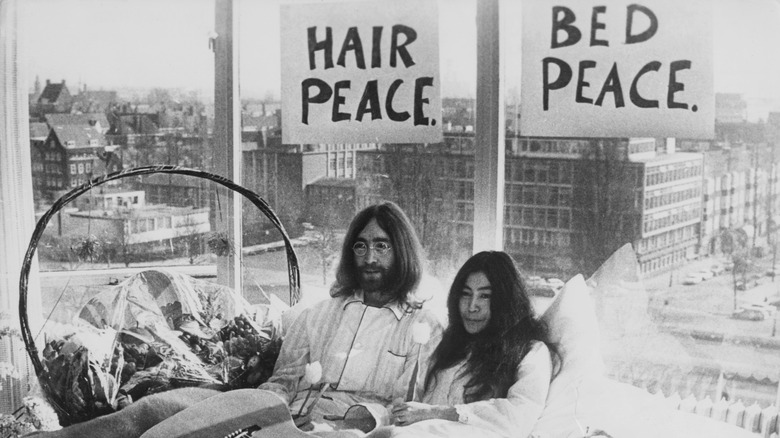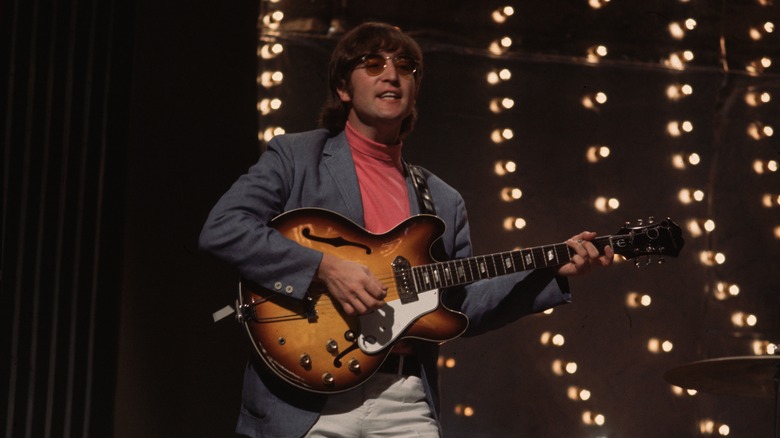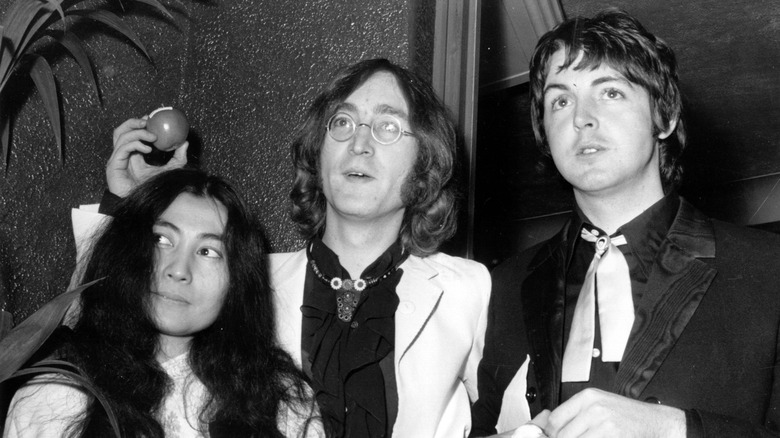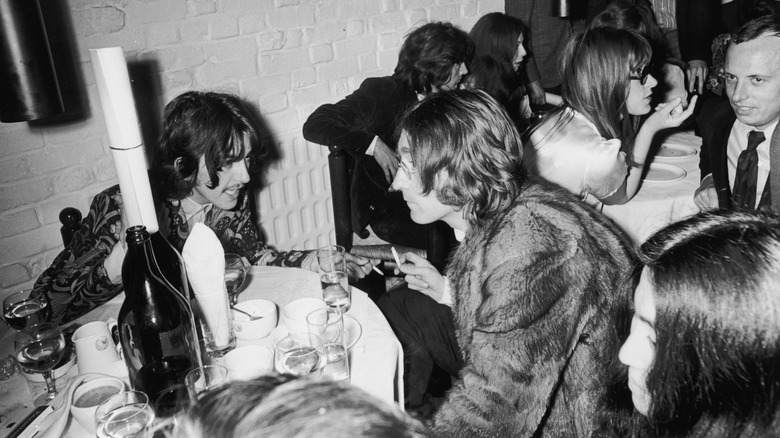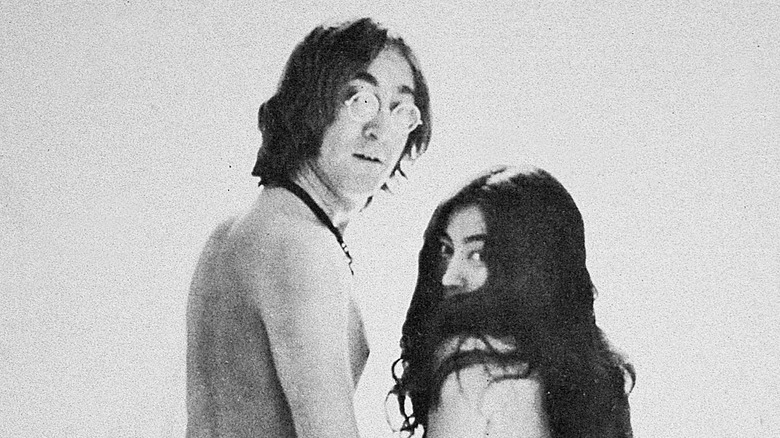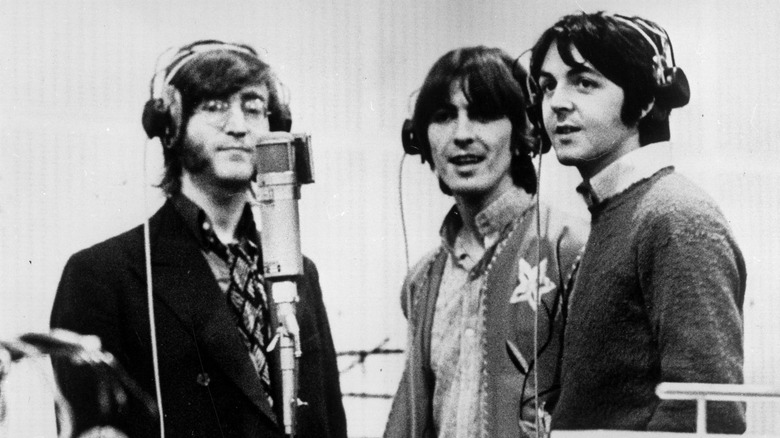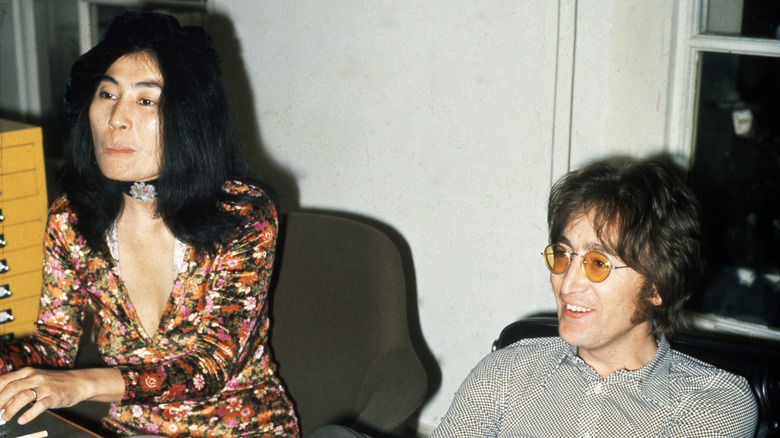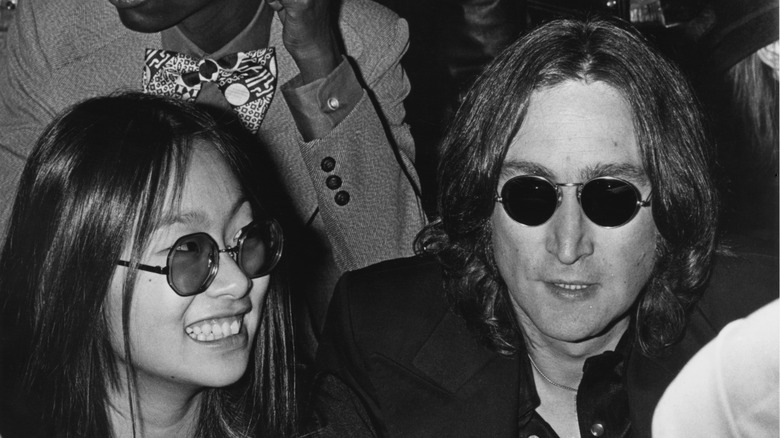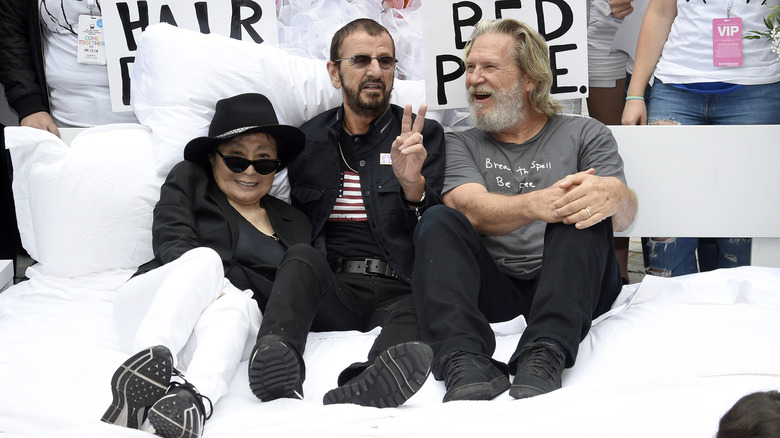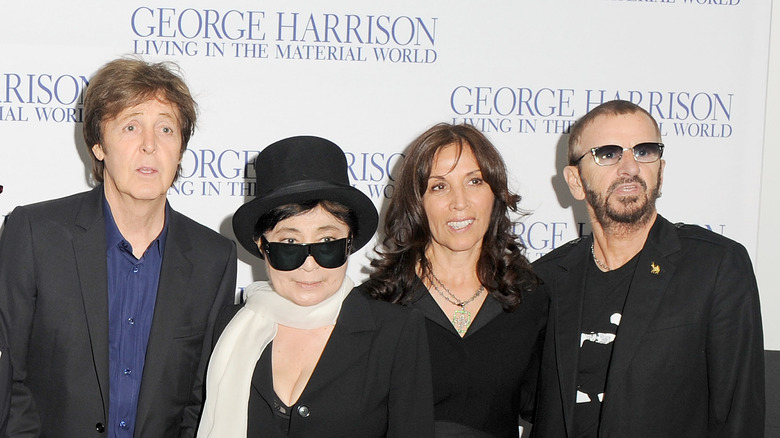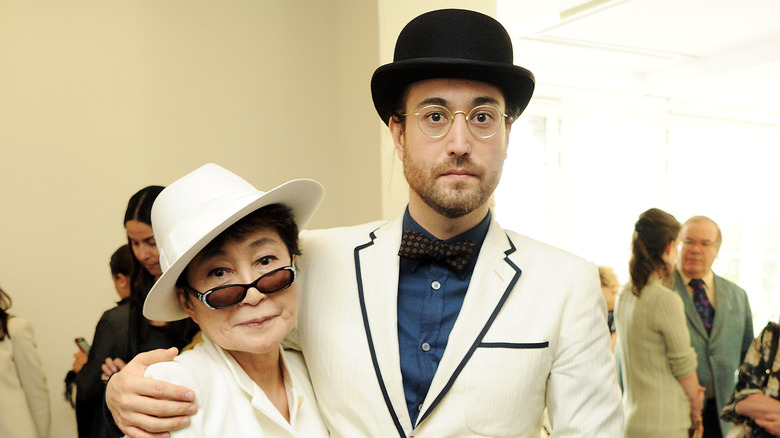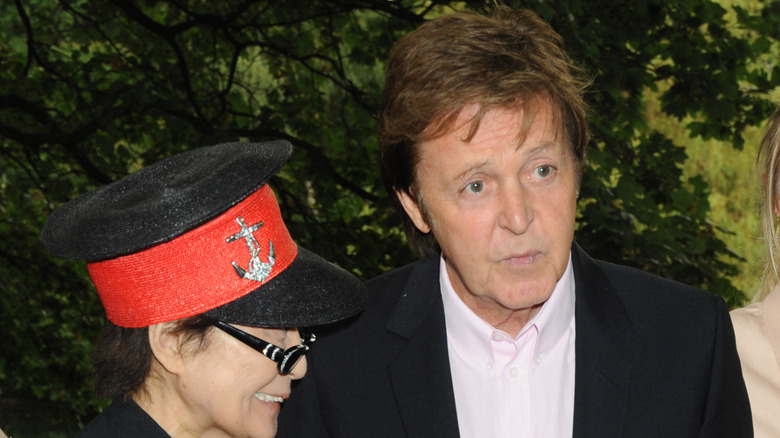What Yoko Ono's Relationship With The Beatles Was Really Like
There has not been a musical act as influential as The Beatles. For the better part of a decade, the four lads from Liverpool reached unprecedented heights in the world of music and pop culture. Heights which have arguably never been reached since. In the middle of their conquest of the music charts, the group's lead singer and songwriter, John Lennon, met an artist from seemingly a completely different background.
As Ozy explains, Yoko Ono was born in 1933 to a wealthy Japanese family, but during World War II, her father became a prisoner-of-war, leaving her remaining family struggling to survive. Ono came to the United States to attend Sarah Lawrence College. She became involved in New York City's avant-garde art movement during the late 1950s and 1960s, becoming an underground concept artist. Eventually, she came across Lennon, one of the biggest names in the entire world.
The two immediately fell in love, connecting on everything from their art to their politics. Because of Lennon's celebrity status attracting press cameras wherever he went, it was impossible for the couple to have a private love life, and they seemed to take full advantage of this reality. While Lennon's feelings for Ono were clear, what was more mixed was the rest of The Beatles' feelings for her. Here is the story of Yoko Ono's relationship with The Beatles.
Meeting John Lennon
According to USA Today, 1966 was an important year for The Beatles. After recording their landmark album, "Revolver," the group would launch what would be their final tour. After three years of crazed fans following the group, the foursome had become discontent with touring. John Lennon sparked a massive controversy while touring by comparing their popularity to Jesus, adding gasoline to a wildfire. The summer tour was a struggle, with even members thinking about life after the band. Returning to England, Lennon's life would soon change.
Far Out Magazine reports that on November 9, 1966, Yoko Ono held an art exhibition in London, titled "Unfinished Paintings and Objects," and at the behest of a colleague and art dealer John Dunbar, Lennon attended the exhibition. According to Ultimate Classic Rock, Lennon at first was taken back by the avant-garde exhibition, crudely complaining he felt the art would be more sexual and was "expecting an orgy." Ono approached Lennon and gave him a piece of paper that said, "breathe." He followed the direction and soon was attracted to one of Ono's works, a ladder that led to a small word on the ceiling that required a magnifying glass.
"And in tiny little letters it says 'yes.' So it was positive. I felt relieved. It's a great relief when you get up the ladder and you look through the spyglass and it doesn't say 'no' or 'f*** you' or something, it said 'yes,'" he said to Rolling Stone in 1971.
Yoko Ono's Inclusion leads to Paul McCartney's Dissatisfaction
By early 1968, The Beatles began work on "The White Album." Much of the album was written while in India, with the group traveling to the country to find enlightenment from the Maharishi Mahesh Yogi, only to leave unsatisfied. According to Louder Sound, the album was recorded like four solo albums by each member, illustrating the continued separation between the Beatles.
Producer George Martin said that the album's recording session was the first time Yoko Ono was in the studio, The Independent reports. Ono's and John Lennon's relationship continued to blossom in the chaos, leaving the group, especially Paul McCartney, to question her presence in the studio. "We were kind of threatened [then]," Paul said to Rolling Stone in 2016. "When John got with Yoko, she wasn't in the control room or to the side. It was in the middle of the four of us."
In a conversation with Paul McCartney, his wife Linda McCartney, and documentarian Michael Lindsay-Hogg in January 1969, Paul expressed his frustration with Ono within the band as they struggled to find their bearings during a tense period. "There's only two answers: one is to fight it, fight her and try to get the Beatles back to four people without Yoko. ... The other things is to just realize she's there and he's not going to split with her just for our sakes."
George Harrison and Yoko Ono
As an individual musician, George Harrison was just as talented as any of his bandmates. However, as Far Out Magazine explains, having the team of John Lennon and Paul McCartney taking up the spotlight and space on albums, Harrison's own creativity was usually stifled. Much of the resentment he already had at this reality was exacerbated by Yoko Ono's presence, leading her to become a pillow that Harrison screamed into when frustrated.
"And George ... insulted her right to her face in the Apple office at the beginning, just being 'straight forward' you know, that game of 'well, I'm going to be upfront because this is what we've heard and Dylan and a few people said she's got a lousy name in New York, and you gave off bad vibes,'" recalled Lennon of Harrison's immediate disdain towards Ono.
In one episode, recounted in "Here, There and Everywhere," by Geoff Emerick (via Far Out Magazine), Harrison snapped at Ono for taking one of his biscuits during a recording session, and by the time of their final album, "Let It Be," Harrison reached his breaking point. According to I Heart Radio, Harrison left the band for a week after a dispute over plans for a performance he felt was "very expensive and insane."
Lennon said following Harrison's initial departure, "it's a festering wound." The years of frustration with the band seemed to subside once the group ended. After the group's break-up, Harrison and Lennon had one of the closest relationships of any Beatle, which included having a close relationship with Ono.
John Lennon and Yoko Ono's Music with and without The Beatles
Ultimate Classic Rock says two of the Beatles' most famous later songs were inspired by Yoko Ono. First and most obvious, "The Ballad of John and Yoko" told the story of the couple. The second, "Get Back" is up to much debate. Despite Paul McCartney's claims Ono was not on his mind, John Lennon angrily believed his friend was telling his girlfriend to stay away from the band through song.
"Get Back" shows Lennon's mental state with people outside his relationship: He was extremely protective of Ono and showed his teeth to anyone he believed disrespected her. According to Radio X, the period between late 1968-early 1969, the couple grew closer together because of the continued racist attitudes the press had towards Ono, Lennon's own drug addiction, and their failed attempt at having a child. While McCartney attempted to work around the new member of the band, Lennon desired to work on music outside the Beatles.
In November 1968, Lennon and Ono released their first of a trio of albums titled, "Unfinished Music No. 1: Two Virgins," featuring the couple fully nude on the cover. According to Ultimate Classic Rock, the album had to be put into a brown paper bag to cover all but the couple's face in order to be sold. Despite making music outside of the group and Ono's presence negatively affecting the other members, Lennon still desired to be in the Beatles, as per a conversation between McCartney and Michael Lindsay-Hogg.
Paul McCartney and John Lennon's Post Break-up Anger
According to the Beatles Bible, on September 20, 1969, John Lennon told Paul McCartney and Ringo Starr that he was leaving the group. McCartney said he figured Lennon was more focused on working with Yoko Ono than the group. "I must admit we'd known it was coming at some point because of his intense involvement with Yoko. John needed to give space to his and Yoko's thing. Someone like John would want to end The Beatles period and start the Yoko period."
According to the Independent, Lennon's announcement that he ended the group was an emotional climax from a fight he was having with McCartney. At the time, Ono was unaware of her husband's plans, surprised when he told her, "From now on, it's just you, OK?"
Once again, Ono was more of an emotional lightning rod used by the members of the band to vent their frustration. In song, McCartney made his frustrations heard on what he felt about the couple, as told in Ultimate Classic Rock. His 1971 song, "Too Many People," which was written shortly after the breakup, took multiple shots at Lennon and Ono with the lyric, "That was your first mistake / You took your lucky break and broke it in two."
Lennon responded that same year with "How Do You Sleep?" According to Rolling Stone, the Lennon-penned song took multiple shots at McCartney and even hinted at the myth he had died years earlier.
Anger of the media
Yoko Ono became the press' whipping girl shortly after the group's breakup, calling her "a dragon lady," according to the AP News. Both John Lennon and George Harrison attempted to set the record straight about the group's demise. In a November 1971 interview on "The Dick Cavett Show," Harrison admitted he was still in contact with the couple and cleared up the rumor that Ono was the cause of the group's demise. "The group had problems long before Yoko came along. Many problems. ... Some people can't understand because the Beatles were such a big deal. ... But there's a time when people grow up, and they leave home or whatever they do and they go through change."
Two months prior, Lennon and Ono were on the program, and Lennon gave his take on the end of the band and his wife being scapegoated by fans and reporters. "She didn't split The Beatles because how can one woman split The Beatles. The Beatles were drifting apart on their own."
In spite of past anger, the end of the Beatles in a lot of ways helped Lennon's and Harrison's relationship. As told by Guitar World, Harrison played guitar throughout Lennon's "Imagine" album, seemingly accepting Ono as a part of the recording process. According to Far Out Magazine, part of Harrison's initial anger towards Ono was jealousy, as he and Lennon had grown especially close after experimenting with LSD before Lennon met Ono.
A Tumultuous Marriage
In spite of portraying themselves as a loving couple, John Lennon's own relationship with his wife was not always happy. "It wasn't easy being married to Yoko Ono," Fred Seaman, Lennon's personal assistant, told "Anna's Beatle Hour." "It wasn't a fairy tale that they later portrayed to the media, which was really propaganda to sell the record."
By 1973, the relationship had reached its final stages. The couple separated in July, and Lennon soon began an affair with their personal assistant, May Pang. Surprisingly, Ono was fine with the relationship, seemingly apathetic towards her husband's relationships by that time. "The affair was not something that was hurtful to me," she said to The Telegraph in 2012. "I needed a rest. I needed space. I started to notice that he became a little restless on top of that, so I thought it's better to give him a rest and me a rest."
During his 18 months with Pang, Lennon reconnected with his first wife and their son, Julian, as per The Beatles Bible. He also performed again with Paul McCartney and continued to make albums. Eventually, he returned to Ono, in part, thanks to McCartney, as told by The Times. McCartney acted as a middleman between the two separated spouses as they worked through their issues. Whether it being a case of time healing all wounds or a friendship that was always there, Lennon and Ono got back together and had a son named Sean.
Ringo Starr and Yoko Ono
Out of all the Beatles, drummer Ringo Starr was the only one who maintained a good relationship with each member after the breakup. And unlike George Harrison or Paul McCartney, Starr was friends with Yoko Ono during the group's final years together. "I was saying to John, 'what is going on here? You're always together all the time, you're freaking me out a bit,'" Starr said in a 1977 interview regarding Ono's presence in the studio. "And he told me what they were trying to do, it has nothing to do with you or the listening public. So I was fine after that. ... That's fine with me and then I sort of relaxed a lot around Yoko. I think she's hysterical. I played on an album with her."
According to Globe Media Live, Starr repeated that after he had a conversation with Lennon, he understood why Ono needed to be in the studio and said her presence did not interfere with the music or the group's eventual split.
Any hopes of a reunion ended the night of December 8, 1980, when John Lennon was fatally shot four times in the back by crazed fan Mark David Chapman, History reports. Immediately upon hearing the news of his friend's death, Starr flew to New York to be with Ono and 5-year-old Sean.
According to Ultimate Classic Rock, at Ono's insistence, the drummer played with Sean to distract him from losing his father.
A fight over Songwriting Credit
Yoko Ono's relationship with Paul McCartney has been a roller coaster, putting it mildly. For a time, the death of John Lennon brought the pair closer together, with McCartney even admitting to his own fault in the relationship in an interview. However, the pair still struggled to find common ground and returned to each other's throats when McCartney desired to alter credit for songs he and Lennon wrote.
According to the Irish Examiner, McCartney wanted to change the credit for a number of songs from Lennon/McCartney to McCartney/Lennon. The songwriting duo had agreed their writing credits would give Lennon top billing for all Beatles tracks, even if the other had little involvement. While songs like "Nowhere Man" and "Come Together" were written by only Lennon, as Far Out Magazine reports, McCartney's name is still credited. When McCartney released the live album, "Back in the U.S.," in 2002, he switched the billing on Beatles songs he wrote himself.
Ono and her legal team fought to prevent the name switch. "This was done against her wishes. It's ridiculous, absurd and petty," said her lawyer, Peter Shukat. "Paul is hurting his own legacy with this. ... John's not here to argue." According to Billboard, McCartney pushed back at Ono and her legal team: "I think it is fair and accurate for the songs that John declared were mine to carry my name first."
In spite of the threats, Ono did not file a lawsuit.
Yoko Ono After John Lennon's Murder
Widowed, grieving, and now a single parent, Yoko Ono became the voice for John Lennon's legacy. An artist in her own right, Ono has overseen and has given the thumbs up (or down) to Lennon's music, art, and image in different campaigns and projects. According to the Tampa Bay Times, Ono's net worth is around $500 million to $1 billion.
This in part came from her defending her husband's name, image, and music like a hawk. Bella Online reports that Ono, as well as the remaining Beatles, filed lawsuits against Apple Computers for their apple logo that was taken from the band's Apple Records. The group also filed suit against a bootleg recording of the group's early Hamburg shows.
In 1988, the Fab Four was elected into the Rock and Roll Hall of Fame. According to Cleveland, while George Harrison, Ringo Starr, and Ono were in attendance, Paul McCartney was absent. "After 20 years, the Beatles still have some business differences, which I had hoped would have been settled by now," he said in a statement. "Unfortunately, they haven't been, so I would feel like a complete hypocrite waving and smiling with them at a fake reunion.”
Six years later, Ono and McCartney met at the Rock and Roll Hall of Fame when Lennon was inducted as a solo artist. Seemingly on better terms, Ono worked with the three remaining Beatles on an anthology documentary and album, giving the members songs Lennon wrote before his death, Ultimate Classic Rock reports.
Her Relationship with The Beatles Today
Time and tragedy tend to heal all wounds. With George Harrison's death in 2001, the two remaining Beatles have seemed to make peace with Yoko Ono and their past feuds. At the same time, Ono has seemed to have forgiven the ill feeling once held against her by her husband's bandmates.
In 2015, when Ringo Starr was inducted as a solo artist to the Rock and Roll Hall of Fame, Ono said, "he was the most influential Beatle," and he "embodies peace and love," as told by Rolling Stone.
With Paul McCartney, Ono has had a number of public fights. However, the past few years have seen the two be less litigious and more supportive. Speaking to Howard Stern in 2018, McCartney reminded the public it was Lennon's decision, not Ono's, to end the band: "There was a meeting where John came in and said, 'Hey guys, I'm leaving the group.'" He also said he came to an understanding that he and Ono wanted to work together. "John had met up with Yoko and even though we thought it was a bit of an intrusion ... looking back on it, the guy was totally in love with her and you just gotta respect that. And we did, and I do."
In 2021, McCartney told the BBC once again that it was Lennon's decision to end the band. Ono told the Guardian in 2012 that McCartney "was very brave" and that she loved him aftet McCartney first went on record to say that Ono was not to blame for the band's demise.
